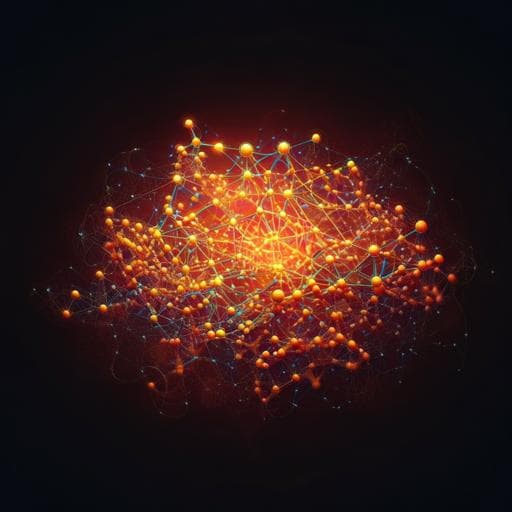
Physics
Simulating molecules on a cloud-based 5-qubit IBM-Q universal quantum computer
S. Leontica, F. Tennie, et al.
In an exciting breakthrough, researchers S. Leontica, F. Tennie, and T. Farrow showcase an innovative method for simulating complex quantum systems using IBM's quantum computer. Their work involves the efficient transpilation of quantum states, paving the way for advanced simulations in molecular settings like the Fenna-Matthews-Olsen photosynthetic protein.
~3 min • Beginner • English
Introduction
The paper addresses how to efficiently simulate quantum dynamics of complex systems on near-term universal quantum computers, overcoming the exponential resource scaling of classical simulations. It contrasts universal quantum computers with analogue quantum orreries and focuses on the circuit model comprising single-qubit rotations and CNOT gates. Motivated by NISQ-era hybrid variational algorithms that require compact unitary blocks (ansätze) acting on small subsets of qubits, the authors aim to design optimal decompositions for three-qubit gates to build larger circuits modularly, enable piecewise process tomography, and reduce cross-talk. They further position this within the context of simulating open quantum systems, where device noise can mimic environmental effects. As a domain example, they discuss energy transport in the seven-site Fenna–Matthews–Olson (FMO) complex and the concept of environment-assisted quantum transport (ENAQT), where an interplay between coherence, dephasing, and relaxation can enhance transport efficiency. The study proposes a practical transpilation approach for unitary evolutions into universal quantum circuits, implemented and tested on IBM’s 5-qubit devices, with an emphasis on three-qubit decompositions and noise-aware execution.
Literature Review
The authors review models for quantum simulation and computation, including universal digital quantum computers and analogue quantum orreries, noting existing platforms (superconducting qubits, photonics, ion traps, NMR). They highlight the circuit model and the promise of quantum algorithms over classical ones. They discuss NISQ-era hybrid variational methods (e.g., UCC Ansatz) that require unitary synthesis on few-qubit subspaces and mention compiler/transpiler advances (e.g., t|ket⟩). In quantum biology, they summarize research on exciton transport in photosynthetic systems, particularly FMO, and the roles of coherence versus vibrational contributions to observed quantum beats in spectroscopy. They describe ENAQT, balancing localization and Zeno effects, and invariant subspaces for transport efficiency. Prior mathematical foundations include Cartan decompositions and the modified Khaneja–Glaser (K–G) decomposition for factorizing multi-qubit unitaries, along with optimal two-qubit circuit synthesis results, which underpin their three-qubit gate decomposition strategy.
Methodology
The approach targets implementing unitary evolutions U(t)=exp(−iHt/ħ) on a quantum computer by classically computing U(t) for a set of times spanning the relevant dynamics and then decomposing each 3-qubit unitary into a circuit of one- and two-qubit gates. The unitaries considered can be generated by exponentials of sums of low-weight Pauli strings acting nontrivially on three qubits, with parameters serving as classical optimization degrees of freedom. Mapping of the simulated system to device qubits preserves locality: Pauli string weight should scale at most logarithmically with system size, and qubits on which strings act should be as connected as possible according to device topology.
Three-qubit unitary synthesis: Using the modified Khaneja–Glaser (K–G) Cartan decomposition for su(8), an arbitrary U∈SU(8) is factorized as U=K1 F1 K2 H K3 F2 K4, where Fi∈exp(f), H∈exp(h), and Ki∈SU(4)⊗SU(2). Iterative Cartan decomposition yields commuting three-qubit blocks (H, F1, F2) that can be implemented efficiently, and remaining two-qubit gates in Ki are further decomposed into CNOTs and one-qubit rotations using known optimal constructions. Following refs. 19,20,22,23, an arbitrary 3-qubit gate is implemented with at most 73 single-qubit rotations and 26 CNOTs (before device-specific transpilation). The method avoids Trotterization for the 3-qubit case, yielding exact implementations of U(t) on the chosen three-qubit register.
System mapping and initialization: For small systems with up to eight states, the full Hamiltonian is used directly. For the FMO network, an initial equal superposition of sites 1 and 6 is chosen due to their likelihood of excitation; these are mapped to computational basis states differing by a single bit flip (|000⟩ and |001⟩) to mitigate decoherence.
Software and compilation: Phases and parameters for the decomposition are computed in MATLAB, and circuits are emitted as Python scripts using Qiskit for execution on IBM Quantum Experience devices. Transpilation is applied to satisfy device connectivity; for linearly connected devices, additional SWAP/CNOT layers may increase the two-qubit gate count relative to the ideal decomposition.
Hardware and execution: Experiments were performed on IBM five-qubit devices ibmq_santiago (QV=32) and ibmqx2 (QV=8). Typical calibrated error rates on the acquisition day: CNOT ≈6.5% and 1Q ≈0.25% on ibmq_santiago; CNOT ≈12.5% on ibmqx2. Due to sparser connectivity on ibmq_santiago, circuits with nominally 26 CNOTs expanded to ~38 CNOTs after transpilation; ibmqx2 allowed direct implementation without added routing but with higher two-qubit errors. Estimated overall circuit fidelities were ~76% (ibmq_santiago) and ~69% (ibmqx2). Reported experimental results focus on ibmq_santiago due to large systematic errors observed on ibmqx2. Classical verification used the QASM simulator for up to 32 qubits.
Error characterization and mitigation: Errors are categorized as SPAM, statistical, and systematic. SPAM errors are mitigated via calibration and filtering using Qiskit Ignis measurement mitigation. Statistical errors are reduced by using the maximum shots per circuit and repeated runs (with caution to avoid drift-induced systematics). A simple noise model assumes that with probability p the system jumps to a random state and remains there, modeled as ρ=(1−p)ρs+p I/8. Since the 8th basis state does not participate in the dynamics for seven-site models, its population serves as a noise proxy. Mitigation subtracts counts from site 8 uniformly across all sites and renormalizes, and performance is quantified by an accuracy metric A^2=(1/N)∑(yi−f(xi))^2−σi^2 relative to classical simulations.
Benchmark problems:
- Linear ordered 7-site chain: H=∑n |n⟩⟨n+1|+h.a., with zero site energies and unit nearest-neighbor coupling. Dynamics discretized into 75 time points; each point averages three jobs of 8192 shots on ibmq_santiago.
- FMO complex: 7×7 Hamiltonian (in cm−1 units, shifted so the receptor site energy is 0) as given in Eq. (10). Initial state is an equal superposition of sites 1 and 6. Site populations are measured over time on ibmq_santiago and compared with classical and QASM simulations.
Key Findings
- Three-qubit unitary synthesis: Using a modified Khaneja–Glaser Cartan decomposition for su(8), the authors implement arbitrary 3-qubit unitaries with at most 73 single-qubit rotations and 26 CNOTs prior to device-specific transpilation, providing an exact (non-Trotterized) mapping of U(t) for three-qubit subsystems.
- Hardware execution: On ibmq_santiago (QV=32), transpilation for line connectivity increased CNOT count from 26 to 38. Typical error rates were ~6.5% (CNOT) and ~0.25% (1Q). Estimated circuit fidelity ~76% (ibmq_santiago) and ~69% (ibmqx2), though results are reported from ibmq_santiago due to large systematics on ibmqx2.
- Linear chain dynamics: Experimental populations show a propagating excitation reflecting at boundaries, consistent with classical and QASM simulations. Noise-mitigated data achieved a standard deviation from classical predictions of ~0.06. A recurrent systematic anomaly (a bump at site 1 around t≈4.5 a.u.) suggests device-specific systematic error.
- FMO dynamics: Populations show slight delocalization, with sites 3, 4, and 7 negligibly populated, consistent with the large energy mismatches and weaker couplings. Compared to the linear chain, deviations from classical curves are larger, indicating the simple noise model’s limitations for fully connected Hamiltonians; overestimation of peaks at sites 1 and 2 and underestimation at site 6 were observed.
- Noise model validation and fidelity estimate: The non-participating site 8 showed an average population of 0.053±0.01 across runs, indicating parameter-insensitive noise. Using ρ=(1−p)ρs+p I/8, p≈0.42 was inferred, implying an experimental circuit fidelity ≈0.65, slightly below the rough estimate from gate errors (likely due to calibration drift and unaccounted T1/T2 during idle periods). Mitigation via subtracting site-8 counts and renormalizing substantially reduced deviations, with a drastic improvement in the accuracy metric A^2 (details in Supplementary Note 3).
- Generality and applicability: The approach is theoretically exact for three-qubit unitaries, composable, and suitable for near-term variational and simulation algorithms where low-weight Pauli terms dominate. Errors appeared more sensitive to circuit structure than to parameter values, enabling benchmarking at the ansatz level.
Discussion
The study demonstrates that exact three-qubit unitary decompositions via Cartan/K–G techniques can be compiled and executed on contemporary 5-qubit IBM devices to reproduce key qualitative features of target dynamics for both ordered chains and a realistic molecular system (FMO). This addresses the research goal of testing whether universal NISQ hardware can faithfully realize unitary blocks required for quantum simulations without Trotterization. The observed agreement with QASM and qualitative correspondence with classical simulations confirm the correctness of the transpilation strategy; deviations on hardware are dominated by systematic device noise rather than synthesis errors. The nearly parameter-independent noise level suggests that circuit topology, not variational parameters, chiefly determines error accumulation—a useful property for ansatz benchmarking and error-aware design.
For the more complex FMO Hamiltonian, increased discrepancy indicates that simple uniform-mixing noise models are insufficient; nonetheless, the mitigation strategy using a non-participating state as a noise monitor significantly improves correspondence with classical predictions. This highlights a pathway to incorporating device noise as a modeling resource for open-system simulations, where environmental noise is intrinsic. Overall, the work reinforces the viability of modular three-qubit unitary blocks as building elements for near-term quantum simulation algorithms while emphasizing the necessity of improved calibration, connectivity-aware transpilation, and advanced mitigation for quantitative accuracy.
Conclusion
The authors present an efficient, exact method to transpile unitary evolutions of three-qubit subsystems into universal quantum circuits using a modified Khaneja–Glaser Cartan decomposition, implemented via custom MATLAB tooling and Qiskit integration. They validate the approach experimentally on IBM’s 5-qubit hardware, demonstrating dynamical simulations for a seven-site linear chain and the FMO complex. A simple, effective noise-mitigation technique leveraging a non-participating state substantially improves agreement with classical simulations. The work establishes the practicality of exact three-qubit unitary blocks for NISQ-era quantum simulations, suitable for variational and Hamiltonian-evolution algorithms without Trotterization.
Future directions include: integrating quantum error correction or detection to boost output purity and enable larger modular compositions; scaling beyond three qubits with optimized transpilation (e.g., ZX-calculus-based rewrite rules); incorporating mid-circuit measurement/reset and ancilla-based channels to simulate general open-system dynamics; and tailoring device noise or employing statistically averaged Kraus-operator realizations to emulate specific environments, albeit with increased circuit counts.
Limitations
- Output state purity from the three-qubit block is currently insufficient for seamless integration into larger circuits without error correction.
- Device constraints (limited connectivity) require additional routing, increasing CNOT counts and error accumulation; exact three-qubit decompositions do not scale efficiently to larger registers.
- Significant systematic errors and calibration drift impact quantitative accuracy; only ibmq_santiago data are reported due to large systematics on ibmqx2.
- The simple uniform-mixing noise model (ρ=(1−p)ρs+p I/8) captures average behavior but fails to explain all site-specific deviations for complex Hamiltonians (e.g., FMO), indicating the need for more sophisticated calibration and error models.
- Lack of mid-circuit measurement/reset and limited ancilla control hinder direct implementation of general open-system dynamics; current work relies on precomputed unitaries and post-hoc mitigation.
- Fidelity estimates did not explicitly account for decoherence during idle periods, contributing to discrepancies between predicted and observed fidelities.
Related Publications
Explore these studies to deepen your understanding of the subject.







